Picto Diary - 22 April 2017 - Cochin
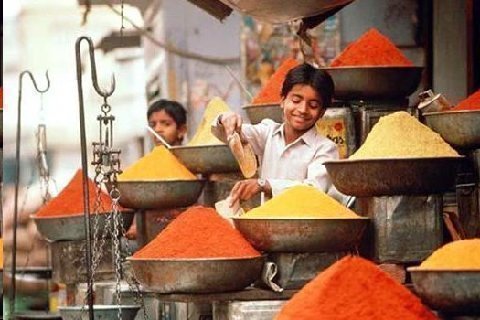
Above: Cochin spice file image. Cochin, India. 22 April 2017.
"He who controls the spice controls the universe."
Frank Herbert, "Dune."
Today marks my second visit to Cochin, TIMDT's third. We cruised in here together in November of 2012. Then, on a Seabourn ship, we were headed the opposite direction, Athens to Singapore. Through Dubai on that voyage, we sailed with Eton Mum and el Contador. From Dubai, we were joined by Montage and SpaGo.
Originally founded by the Portuguese very early in the 16th Century, Cochin became a British and Dutch trading center one hundred years later when the Portuguese moved the center of their spice trading to operations to Goa, further north on the Malabar Coast. Colonial buildings and neighborhoods from both periods remain. There is even a "Jew Town" and an active Synagogue, which we visited the last time we were here.
In the foothills of the Western Ghat mountain ranges 30 to 40 miles from the Malabar coastline, rainfall and topographic conditions combine to create conditions where grow the bulk of the spices used in the world, even today.
European passion for spice... mainly black pepper, which grows on a vine, drove European civilization's growth. Ships and navigation technology grew and huge capital amounts were amassed by the risk taking traders in spice. The capital produced from the spice trade was eventually there to finance the industrial revolution.
It all seems so quaint here... but when you put the place in context of the hullabaloo that spice caused, it also seems quite sobering.
Having already visited most of the colonial spots in town, we, today, expect to visit a couple of spice farms later in the voyage, further up the Malabar coast, in Mangalore and Goa. Today, we'll visit a cultural museum, a Kerala village, and some of TIMDT's favorite India shops in old colonial Cochin.
We departed from the ship tour bus hoards and, with the assistance of TravelScope India, hired a car and a driver.
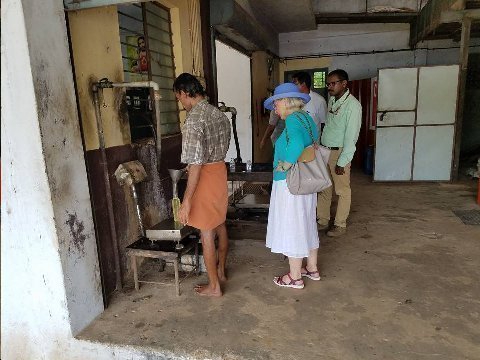
Above: TIMDT obtains bottle of pure coconut oil at Chackukkal Extractors, Viakom, Kerala. 22 April 2017.
Guide Sabu (green shirt), who is 50, maintains that using coconut oil in his hair, daily, has prevented his hair from turning grey.
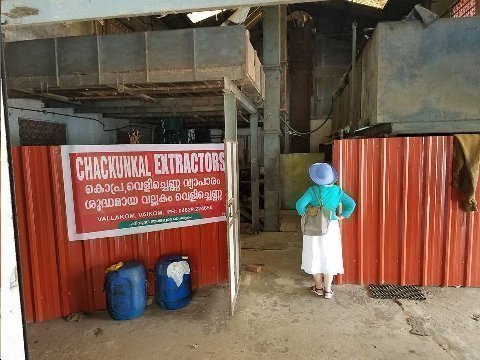
Above: TIMDT observes coconut oil extraction process. Chackukkal Extractors, Viakom, Kerala. 22 April 2017.
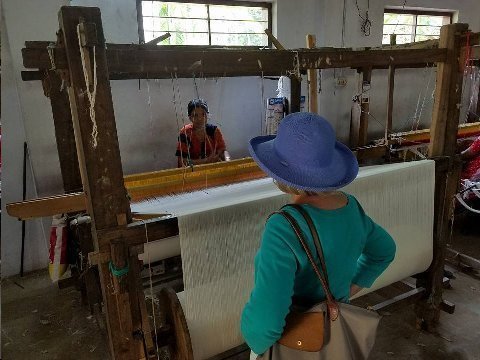
Above: TIMDT observes hand looming cotton cloth for dhotis. Kulasekharamangalm, Kerala. 22 April 2017.
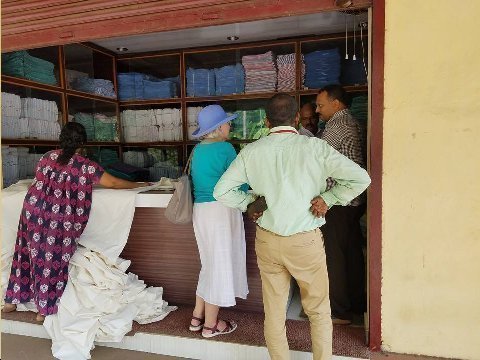
Above: TIMDT makes purchase of dhoti for Hoops. Kulasekharamangalm, Kerala. 22 April 2017.
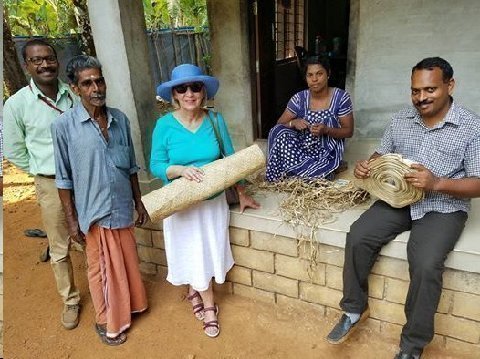
Above: TIMDT and friends at Kulasekharamangalm, Kerala. 22 April 2017.
Guide Sabu is at left. Sabu's helper at the village, Arjun, is at right. Homeowner wears the longi and his daughter, weaving a mat from palm leaves.
TIMDT holds her sleeping mat purchase.
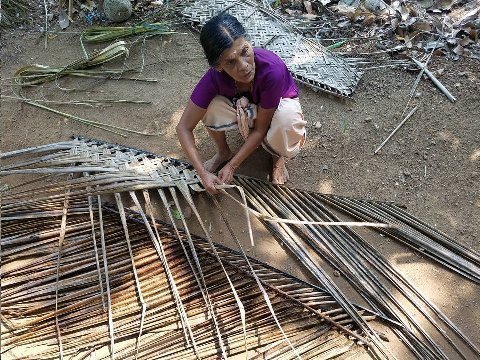
Above: Village woman weaving palm fronds. Kulasekharamangalm, Kerala. 22 April 2017.
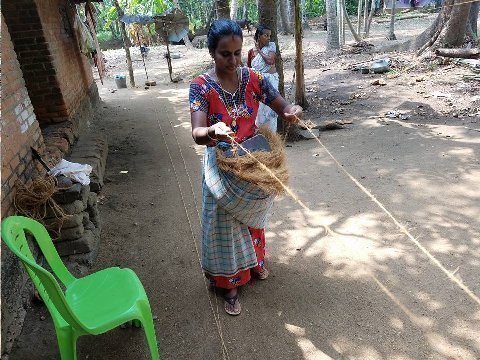
Above: Village woman making rope from coconut husk strands. Kulasekharamangalm, Kerala. 22 April 2017.
This is what Gandhi wanted for all Indians... for them to be dutifully engaged in cottage industry. While many Indians continue in this vein, they are giving way to technological and industrial practices price them out of their traditional markets.

Above: Rose Apple. Kulasekharamangalm, Kerala. 22 April 2017.
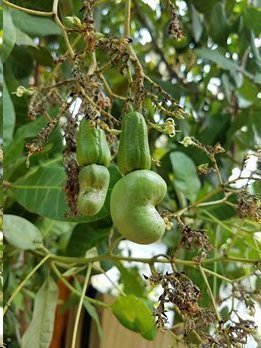
Above: Cashew. Kulasekharamangalm, Kerala. 22 April 2017.
Nut hangs from the fruit, in this image only partially developed. The fruit will grow to several sizes of the nut and eventually turn red.
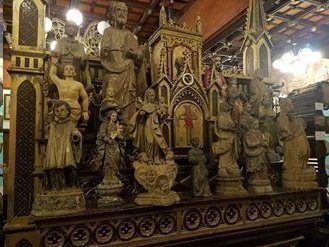
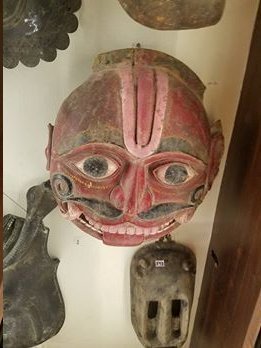
Above: Portuguese, 15th century icons. Hindu carnival mask, 15th century. Folklore Museum. Cochin, Kerala. 22 April 2017.
The two images point to Kerala's ongoing, centuries later, multicultural nature. In "Hindu India," 25% of Kerala's population is Christian. Muslim population of Kerala is 15%.
India remains a very spiritual place were members of all the faiths, including the Christian faith, are active church/temple/mosque goers. India's spirituality contributes greatly to its ongoing cultural energy.
There are 20 million Christians in India. Most are church goers. There are 70 million "Christians" in France. Few are church goers. One could reasonably say that India today is a more Christian nation than France.
Christian churches are sighted frequently as drive through the area.
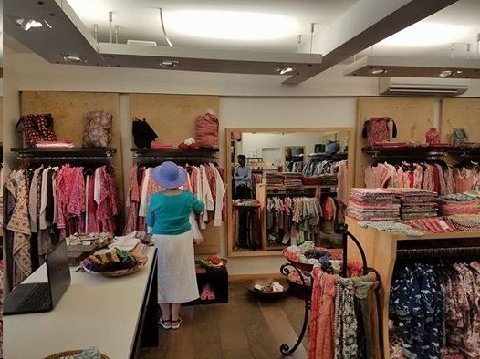
Above: TIMDT shops at Anokhi. Cochin, Kerala. 22 April 2017.
Here she looks at clothes. But this is the place where she gets her table cloths, mainly.
Anokhi's colorful table cloths have brightened up our round table in the kitchen area for years.
Anokhi has branches throughout India. Indiaphile (sic) that she is, TIMDT has been to most of them!
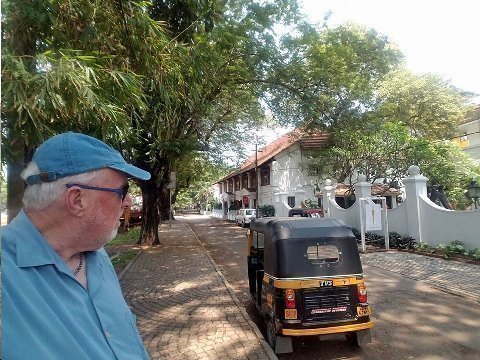
Above: The Bishop. Near Malabar House. Cochin, Kerala. 22 April 2017.
Bishop took a walk through some familiar area while TIMDT shopped at Anokhi. We had lunch at Malabar House when we were here in 2012.
Its hot out. 90 degrees. 85% humidity.
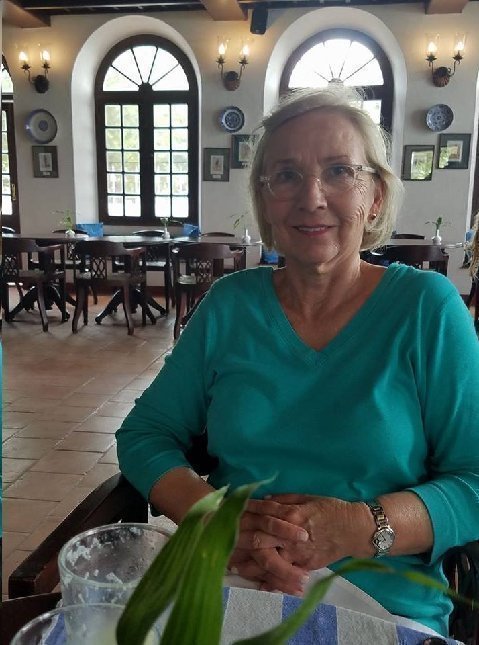
Above: TIMDT. Lunch Brunton Boat Yard. Cochin, Kerala. 22 April 2017.
Coming into the harbor this AM I was alone (!) in the upper observation lounge and TIMDT was in our cabin. When we joined at breakfast, TIMDT excitedly asked me, "Did you see the Brunton Boat Yard as we cruised into the harbor?"
TIMDT was just as happy (see image) when we had lunch at Brunton boat yard today.
I saw it. For us it is an iconic spot. TIMDT stayed there during her first visit to Cochin, accompanied by her cronies. She took me there for a look when we were here together in 2012.
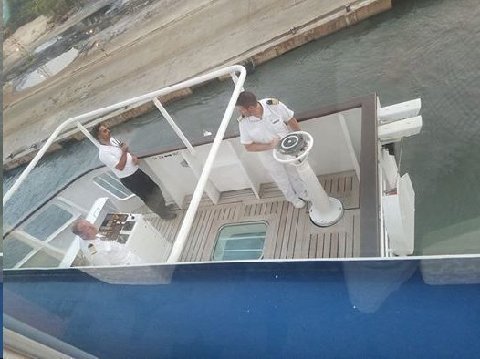
Above: Seven Seas Voyager First Officer at the joy stick, left. Cochin Pilot, dark pants, and another Seven Seas Voyager officer. Cochin, Kerala. 22 April 2017.
At depart from Cochin Harbor. It still seems kind of amazing to me that the First Officer is "driving" this huge vessel from the small panel seen in the image.
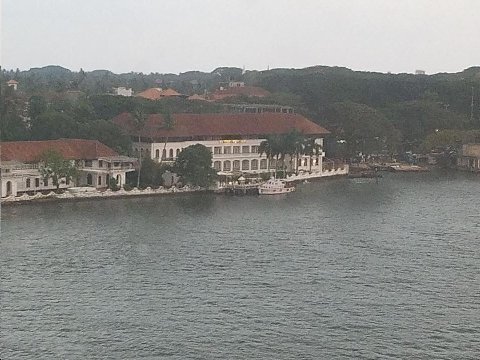
Above: Brunton Boat Yard. Cochin harbor. 22 April 2017.
Iconic for TIMDT... and now, for me!
Look beyond the hotel in the image.... the lush landscape of the Malabar Coast... the spice coast.
Addendum:
Steve,
Your cruise seems to be a very interesting one…I would appreciate your sending me the details. We may want to consider it.
Park Avenue, NY, NY